
- Campus Services
- Budget Office
- Campus Controller
- Campus Planning and Design
- Career and Professional Development
- Event Operations
- Facilities Management
- Fire & Life Safety
- Institutional Compliance and Internal Audit
- Institutional Research and Decision Support
- Legal Affairs
- Mail Services
- Marketing and Public Affairs
- Parking Services
- Public Safety
- Sustainability
- Copy Jobs
- Campus Resources
- Marketing and Public Affairs
»The Greenest Building is the One Already Built
"Preservation saves energy by taking advantage of the non-recoverable energy embodied in an existing building and extending the use of it”
--Advisory Council on Historic Preservation
Chapman University has always practiced values of conservation and preservation as they relate to reusing existing buildings on campus and as we expand. Over the course of the University's 150+ year history, it has worked to restore and repurpose buildings and homes on campus in an effort to reduce raw resource consumption, make use of the embodied energy of already existing structures, and contribute to the historic feel of the Old Towne Orange Community. For more information about this topic, take a look at this article.
Chapman currently has nine buildings that are listed in the National Register of Historic Places and/or with the Old Towne Orange Historic District:
- Memorial Hall- 1921
- Reeves Hall- 1913
- Wilkinson Hall- 1904
- Roosevelt Hall- 1928
- Smith Hall- 1913
- Crean Hall- 1923
- Digital Media Arts Classroom- 1922
- Villa Park Orchards Packing Plant- 1918
- Cypress Street Schoolhouse- 1931
Cypress Street Schoolhouse
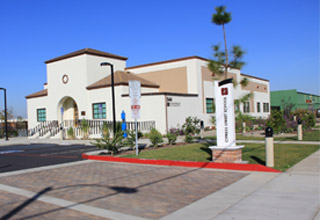
In 2012, Chapman completed its renovation of the Cypress Street Schoolhouse. The Schoolhouse, originally built in 1928, is the last remaining historical segregated school in Southern California. Today, the Schoolhouse has been turned into a state-of-the-art facility and is equipped to support the nationally recognized Early Human and Lifespan Development Research Program. The Cypress Street Schoolhouse achieved LEED Gold in the fall of 2013. The LEED features of this building include a green cleaning plan, an environmentally friendly pest management plan, light pollution reduction, native landscaping, and controllable building systems. For more information on the Cypress Street Schoolhouse building and the programs housed there, please visit our Happenings Blog.
Doti Hall
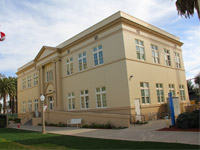
In the winter of 2013, Chapman opened a new classroom building, Doti Hall, named after former University President Jim Doti. While the building didn't pursue LEED certification, it has many sustainable features, and likely would have received LEED Gold Certification had certification been pursued. Sustainable design features of this building include:
- Operable windows for natural ventilation that trigger a sensor to turn off air conditioning or heating when they are opened
- The use of natural light to reduce the lighting load (skylights on the 3rd floor transform into windows that transfer light to inner portions of the building, large classroom windows, and light wells that serve the basement classrooms)
- Dual-paned, high-performance glass, reducing thermal transmission of heating and cooling
- Cool roof: a light-colored, single-ply roof that reduces solar heat gain
- Pre- and post-construction commissioning to fine-tune the building's heating, cooling, electrical, and plumbing systems and to ensure they are operating as intended
- Storm water from the site and roof are collected and filtered before leaving the site
- Low-flow faucets and toilets yield a 20% reduction in water consumption
- Extensive use of recycled materials and finishes
- Construction waste recycling
- It was the first building on campus to implement the new Cal Green Building code requirements, achieving performance that far exceeds normal baseline standards
Wilkinson Hall
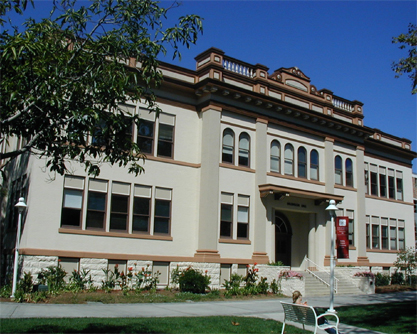 Wilkinson Hall, named after former Trustee, Chairman, and Acting President J.E. Wilkinson,
was originally constructed in 1904 on the Orange High School campus. In 1921, it was
moved 250 feet from where it sat in the middle of what is now Bert Williams Mall and
turned around 90 degrees, coming to rest at its current location. Chapman College,
as it was called at the time, acquired the building in 1954. It now houses the Office
of Academic Affairs, English and Comparative Literature, Graduate Studies, and the
departments of Religion and Philosophy. The building is listed in the National Register
of Historical Places.
Wilkinson Hall, named after former Trustee, Chairman, and Acting President J.E. Wilkinson,
was originally constructed in 1904 on the Orange High School campus. In 1921, it was
moved 250 feet from where it sat in the middle of what is now Bert Williams Mall and
turned around 90 degrees, coming to rest at its current location. Chapman College,
as it was called at the time, acquired the building in 1954. It now houses the Office
of Academic Affairs, English and Comparative Literature, Graduate Studies, and the
departments of Religion and Philosophy. The building is listed in the National Register
of Historical Places.
Memorial Hall

Memorial Hall, the campus capstone with neo-classic columns, was completed in 1921 and is listed in the National Register of Historic Places. The four pillars are said to have inspired the "four pillars of education": spiritual, mental, physical, and social. Originally one of the main academic buildings on campus, today it houses the offices of the President, the Chancellor, the Executive Vice President, Vice President of Campus Planning Operations, and University Relations. The understated elegance has made it an attractive backdrop for scenes in the movies Crimson Tide, That Thing You Do, and Rocky and Bullwinkle.
Smith Hall
 Smith Hall, completed in 1913, is home to the Department of Psychology. This building was built as the Science Building for Orange Union High School and was
acquired by Chapman in 1954. It was named in honor of former University President G.T. (Buck) Smith, who served
as president of the university from 1977 to 1988. Smith Hall was designed by local
Santa Ana architect Fredrick Eley.
Smith Hall, completed in 1913, is home to the Department of Psychology. This building was built as the Science Building for Orange Union High School and was
acquired by Chapman in 1954. It was named in honor of former University President G.T. (Buck) Smith, who served
as president of the university from 1977 to 1988. Smith Hall was designed by local
Santa Ana architect Fredrick Eley.
Reeves Hall
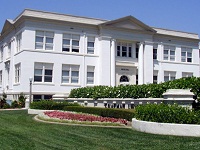
Reeves Hall was completed in 1913 and originally served as part of Orange High School. It was acquired by Chapman in 1954, along with all the other historic properties, and was named in honor of George Reeves, the University President from 1942 to 1956. Reeves Hall is home to the Kathleen Muth Reading Center, the College of Lifelong Learning, and the School of Education. It was designed by local Santa Ana architect Fredrick Eley and is listed in the National Register of Historic Places.
Roosevelt Hall
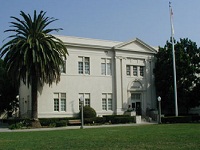 Formerly known as Founders' Hall, Roosevelt Hall was completed in 1928 and is listed
in the National Register of Historic Places. It currently houses Wilkinson College
of Arts, Humanities, and Social Sciences. Acquired by Chapman in 1954, it was originally constructed as the Art & Cafeteria
Building for Orange Union High School.
Formerly known as Founders' Hall, Roosevelt Hall was completed in 1928 and is listed
in the National Register of Historic Places. It currently houses Wilkinson College
of Arts, Humanities, and Social Sciences. Acquired by Chapman in 1954, it was originally constructed as the Art & Cafeteria
Building for Orange Union High School.